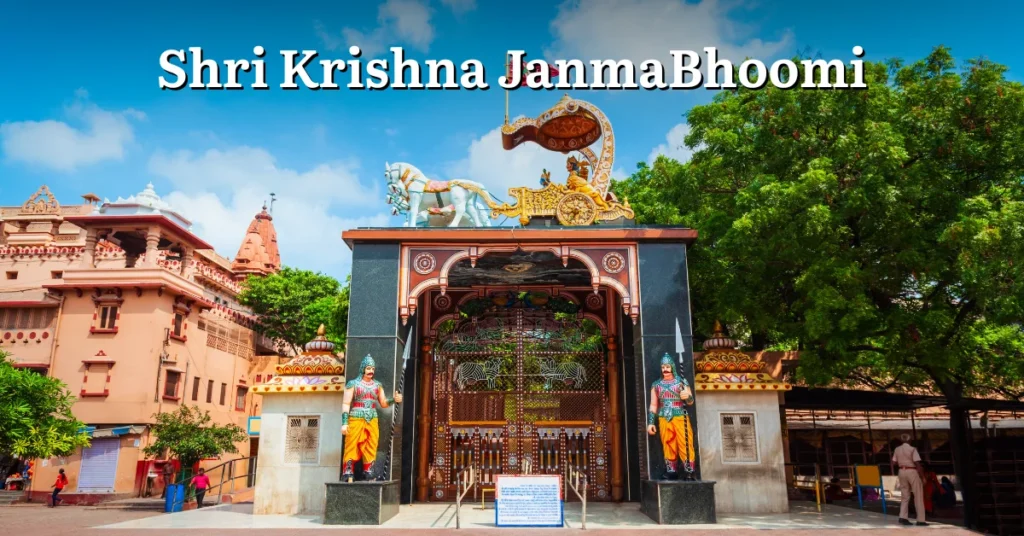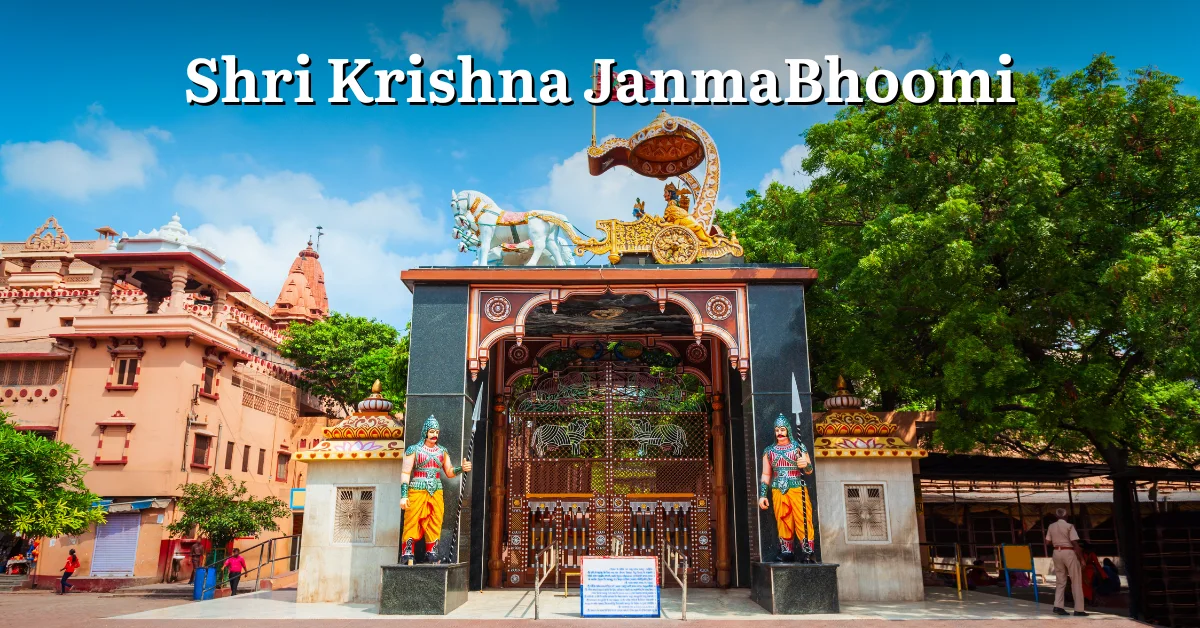For millions of devotees worldwide, the name “Mathura” resonates with profound spiritual energy. It’s the hallowed ground where Lord Krishna, the eighth incarnation of Lord Vishnu, descended to Earth. At the very core of this ancient city lies Krishna Janmbhoomi – the exact, revered birthplace of the beloved deity. More than just a temple, it’s a living testament to faith, resilience, and the eternal power of devotion. Visiting Krishna Janmbhoomi isn’t merely a pilgrimage; it’s an immersion into the very origin of Krishna’s divine leela (play) that continues to inspire humanity. This guide, brought to you by Mathura Vrindavan City , your trusted travel partner in the Braj region, delves deep into the significance, history, and practical details of experiencing this unparalleled spiritual site.
Why Krishna Janmbhoomi is a must visit
Krishna Janmbhoomi isn’t just a point on a map; it’s the epicenter of a rich spiritual and cultural heritage.
- The Divine Descent: Hindu scriptures, primarily the Bhagavata Purana and Vishnu Purana, narrate the miraculous birth of Lord Krishna over 5,000 years ago. Born at midnight in a prison cell (known as Karakahana or Garbha Griha) during the tyrannical reign of King Kansa (his maternal uncle), Krishna’s birth heralded the end of evil and the re-establishment of dharma (righteousness). The Janmbhoomi marks this exact sacred spot.
- Symbol of Hope and Triumph: The story of Krishna’s birth – escaping Kansa’s clutches, being carried across the Yamuna by his father Vasudeva to Gokul – is a timeless narrative of divine protection overcoming adversity. Visiting the birthplace reinforces this message of hope and divine grace.
- Pillar of Braj Bhumi: Mathura, along with Vrindavan, Govardhan, and Barsana, forms the sacred Braj Bhumi – the land where Krishna spent his childhood and youth. Krishna Janmbhoomi is the foundational site, the starting point of his earthly journey filled with enchanting pastimes.
The History and Resilience of Krishna Janmbhoomi
The history of the Janmbhoomi site mirrors the enduring power of faith amidst challenges:
- Ancient Origins: It’s believed that Krishna’s great-grandson, Vajranabh, first built a temple at the birthplace around 5,000 years ago.
- Periods of Destruction and Reconstruction: The site faced destruction several times by invading rulers, most notably by Mahmud of Ghazni in the 11th century and later by the Mughal Emperor Aurangzeb in the 17th century. Aurangzeb built the Shahi Idgah mosque adjacent to the prison cell remains.
- Modern Revival: The current temple complex, known as Shri Krishna Janmabhoomi Temple, was developed primarily in the 20th century through the persistent efforts of devotees and religious institutions. The main temple housing the deities was largely constructed in the 1950s and 60s.
- The Sacred Prison Cell (Garbha Griha/Karakahana): The most sanctified spot within the complex is the small, dark chamber believed to be the original prison cell where Devaki gave birth to Krishna. This ancient stone cell, radiating palpable energy, is the focal point of devotion for pilgrims.

Exploring the Janmbhoomi Temple Complex: A Spiritual Tapestry
The present-day complex is a vibrant hub of devotion, encompassing several significant structures:
The Sanctum Sanctorum & The Sacred Prison Cell (Garbha Griha):
Descend into the revered underground chamber where the divine birth occurred. The atmosphere here is intense with devotion. Silver-plated representations depict the birth scene – Vasudeva, Devaki, and the infant Krishna. The sense of history and sanctity is overwhelming.
Keshavdev Temple:
Built above the prison cell, this beautiful temple houses the enchanting deities of Lord Krishna (Keshavdev) and Radha. The intricate carvings and serene ambiance invite deep meditation and prayer.
Bhagavat Bhavan:
This large hall is dedicated to Shrimad Bhagavatam, the primary scripture detailing Krishna’s life and pastimes. It often hosts religious discourses, kirtans (devotional singing), and spiritual gatherings.
The Potra Kund:
An ancient stepped water tank located near the complex entrance, believed to be where the newborn Krishna’s clothes were washed after his birth. Devotees often take a symbolic dip or sprinkle its water for purification.
The Shahi Idgah Mosque:
Situated adjacent to the complex, this historical structure is a significant part of the site’s complex past. While separate, its proximity is a constant reminder of the layered history of Mathura.
Planning Your Pilgrimage: Essential Visitor Information
Timings Krishna Janmbhoomi :
- Summer (April to September): 5:00 AM to 12:00 PM & 4:00 PM to 9:30 PM
- Winter (October to March): 5:30 AM to 12:00 PM & 3:30 PM to 8:30 PM
(Note: Timings are subject to change, especially during major festivals. It’s advisable to confirm closer to your visit date. Darshan usually closes for a few hours in the afternoon.)
Entry: Entry to the main temple complex is free. However, there might be nominal charges for special darshan or puja offerings. Security is strict, and electronic devices (phones, cameras) are generally not allowed inside the inner sanctums, especially the Garbha Griha. Lockers are usually available near the entrance.
When to Visit Krishna Janmbhoomi : Finding the Perfect Time
- Best Weather (October to March): This is the ideal time for a comfortable pilgrimage. Days are pleasant (15°C – 25°C), and nights are cool, perfect for exploring.
- Festival Magic:
- Janmashtami: The absolute pinnacle! Celebrating Krishna’s birth (usually August/September), the Janmbhoomi becomes the epicenter of global devotion. Elaborate decorations, 24-hour kirtan, chanting of “Hare Krishna,” mesmerizing Jhanki (tableaux) depicting Krishna’s life, and the midnight birth celebration create an electrifying, unforgettable atmosphere. Expect massive crowds – book accommodation well in advance.
- Holi: Experience the festival of colors where Krishna played! Mathura and Vrindavan celebrate Holi with unique, week-long fervor (Phalguna month, Feb/Mar).
- Diwali: Celebrated as the day Krishna defeated the demon Narakasura, temples are beautifully illuminated.
- Monsoon (July-September): Lush greenery, fewer crowds (except Janmashtami), but humidity and rain can be factors.
- Summer (April-June): Very hot (can exceed 45°C), making extensive temple visits challenging, though early mornings/evenings are still possible.
Nearby Places to visit Krishna Janmbhoomi
Mathura and Vrindavan are a treasure trove of Krishna-related sites. Here are essential places to include in your itinerary:
Dwarkadhish Temple (Mathura):
One of Mathura’s largest and most vibrant temples, dedicated to Lord Krishna as the “King of Dwarka.” Famous for its elaborate rituals and colorful architecture.
Vishram Ghat (Mathura):
The most sacred ghat on the Yamuna River, believed to be where Lord Krishna rested after slaying Kansa. The evening aarti here is profoundly beautiful. Boat rides offer serene views.
Banke Bihari Temple (Vrindavan):
Just 15 km away. Home to the captivatingly playful deity of Lord Banke Bihari. Famous for its unique darshan style where the curtains open and close rhythmically.
Prem Mandir (Vrindavan):
A stunning modern architectural marvel built in white marble, intricately carved with scenes from Krishna’s life. Spectacularly illuminated at night.
ISKCON Temple (Vrindavan):
A major center for the International Society for Krishna Consciousness. Known for its spiritual ambiance, enlightening discourses, and beautiful deities of Radha-Krishna.
Govardhan Hill (Around 25 km):
The hill Lord Krishna famously lifted to protect the villagers of Braj from Indra’s wrath. Parikrama (circumambulation) of the hill is a sacred practice.
Nandgaon & Barsana (Around 50 km):
The villages of Krishna’s foster father Nanda Maharaj and Radha Rani respectively, offering unique temples and experiences related to their childhood pastimes.
How to Get to Krishna Janmbhoomi
- By Air: The nearest major airports are:
- Indira Gandhi International Airport (DEL), Delhi: Approximately 160 km away. Well-connected globally and domestically. From Delhi, take a train, bus, or pre-booked taxi/cab to Mathura (3-4 hours).
- Pandit Deen Dayal Upadhyay Airport (AGR), Agra: Approximately 60 km away. Connects to major Indian cities. Easier access to Mathura via road or train (1-1.5 hours).
- By Train: Mathura Junction (MTJ) is a major railway station on the Delhi-Mumbai and Delhi-Chennai routes. It’s well-connected to almost all parts of India. The Janmbhoomi complex is just 3-4 km from the station, easily reachable by auto-rickshaw, e-rickshaw, or taxi.
- By Road: Mathura is excellently connected by national highways (NH-19, NH-44). Regular state-run and private buses ply from Delhi, Agra, Jaipur, and other major cities in North India. Driving by private car or taxi is also convenient.
Tips for a Fulfilling Visit to Krishna Janmbhoomi
- Dress Modestly: Respect the sanctity. Shoulders and knees should be covered (for both men and women). Traditional Indian attire is appreciated but not mandatory.
- Footwear: Remove shoes before entering any temple building. Shoe storage facilities are usually available (nominal fee may apply).
- Security: Be prepared for multiple security checks. Carry minimal belongings. Prohibited items include electronics, leather goods, tobacco, and non-vegetarian food.
- Photography: Strictly prohibited inside the inner sanctums, especially the Garbha Griha. Respect the rules. You can often take pictures in the outer courtyards.
- Crowds & Patience: Be prepared for crowds, especially during festivals, weekends, and mornings/evenings. Maintain patience and queue respectfully for darshan.
- Hydration & Food: Carry water, especially in summer. Pure vegetarian food (Satvik) is widely available around the temple complex. Try local Mathura pedas (sweets).
- Guided Tours: Consider hiring a knowledgeable local guide (ensure they are licensed) from Mathura Vrindavan City to understand the history, legends, and rituals deeply. We offer curated tours covering Janmbhoomi and all key Braj sites.
- Accommodation: Mathura offers a wide range, from budget dharamshalas (guest houses) to mid-range and luxury hotels. Book well in advance for festivals.
Experience the Divine with Mathura Vrindavan City
At Mathura Vrindavan City , we understand that a pilgrimage to Krishna Janmbhoomi is a journey of the soul. Rooted in the Braj region ourselves, we combine deep local knowledge with a genuine passion for sharing its spiritual treasures . We prioritize your safety, comfort, and authentic experience .
Whether you seek a serene solo pilgrimage, a family spiritual retreat, or a comprehensive Braj Yatra covering Mathura, Vrindavan, Govardhan, and Barsana, we design personalized tours that cater to your needs and timeframe. From arranging seamless transportation and comfortable stays to providing insightful guides and managing festival logistics, we handle the details so you can focus entirely on your divine connection.
